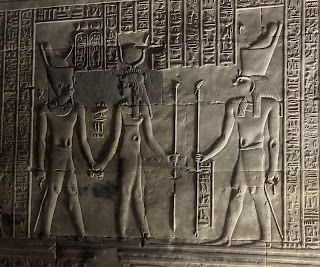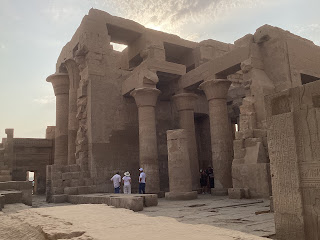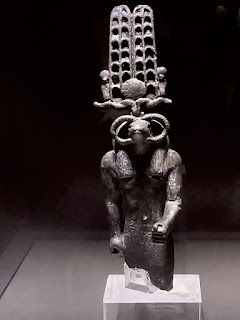Day 22
When I woke up this morning and looked out our cabin window, to my surprise I was not looking at the shore (as I expected), but into the cabin of another boat exactly like ours. Apparently, if there is more than one boat docking, they all have to parallel park (horizontal to the dock), and pull up along side one another like rows of dominoes exactly aligned, so you can walk straight through the foyer of each vessel (if yours is not the one closest to the dock), to get to the gang plank and onto the shore.
So today was an early start as our boat had docked at Edfu along with about 20 others (each carrying around 100 passengers), and everyone was headed to the only tourist attraction in the vicinity, the Temple of Edfu.
To get there and back we had to take a horse and buggy ride, and although I will admit the ride was comfortable, I couldn’t enjoy it (given the poor health and condition of most of the horses), and found the whole experience something I hope I never have to repeat again.
The Temple of Edfu is one of the best preserved shrines in Egypt and was built just over 2100 years ago. Without sounding like a broken record it is made up of the usual columns, statues, shrines, corridors, carvings and false doors that have been present in all the temples we have visited so far. The front entrance even looks a lot like the Temple of Luxor’s. But it does have a few unique points of difference that are pretty cool, like the architectural floor plans being carved into it’s walls along with a full blown storyboard outlining the legendary conflict between the gods Seth and Horus.
For those of you who don’t know, Seth was a god who killed his brother Osiris so he could inherit his throne. However, Osiris’s young son Horus also had his sights set on his father’s throne, so together with his mother and Osiris’s widow (the goddess Isis), he sets about taking revenge on Seth. Now Seth must’ve done his research, because he chose to turn into a Hippo (which according to David Attenborough is the animal most responsible for fatalities annually in Africa), in preparation for his battle against Horus and Isis. His great plan was to hide in the river, wait for them to go for a swim, and then attack. Unfortunately, they got wind of what he was up to, and hired a boat and some very, very long spears. So the great conflict turned out to be nothing more than Horus and his mum enjoying a pleasant afternoon cruising the Nile hunting for the strange Hippo wearing goggles and Speedos.
After we had thoroughly explored the place, we headed back to the boat and set sail for our next port of call, Kom ombo.
We cruised down the Nile for the next four hours and were in our cabin when Maria pointed through our port side window and said, “I think we’re here.” As we came in to dock the Temple of Kom Ombo was clearly visible on the hill overlooking the river, and even though it was yet another temple, it looked pretty impressive.
As with Edfu earlier today, our boat had arrived with about 20 others, (we were about the fourth domino parallel parked along side the other boats), so a very large scrum formed throughout each foyer as passengers fought their way to the gang plank to join another couple of thousand people (looking distinctly disheveled as if they’d gone 10 rounds with Iron Mike), swarming all over the Temple. Luckily our guide Shenouda had the presence of mind to hold us back for a bit and give us an overview of what we were going to see. Five minutes later we enjoyed a leisurely stroll through each foyer to the gang plank and onto the shore.
The Temple of Kom Ombo is an unusual building constructed about 2,100 years ago during the Ptolemaic dynasty with some later additions tacked on during the Roman occupation. It is unique because it is divided into two separate temples (one dedicated to the crocodile god Sobek, the other to the falcon god Haroeris), with everything on one side (columns, statues, shrines, corridors, carvings, halls, sanctuaries, rooms, and false doors) duplicated on the other.
The dual temples also host a few unique gems; the Egyptian calendar (still used by farmers today), a set of surgical instruments used by the healers in ancient times, and a Nilometer used for measuring the water level of the river Nile. Then there is the Crocodile Museum which has on display a few of the three hundred crocodile mummies discovered in the area by archaeologists over the years. Fascinating stuff.
Tonight we had a special Egyptian BBQ on the sundeck requiring everyone to wear a Galabeya. So Maria and I frocked up while Wim played it cool (rejecting my suggestion to just wear his vestments), and together enjoyed a scrumptious dinner with all the other guests of whom most were similarly attired.









































No comments:
Post a Comment